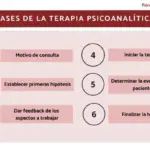
The term structure allows us to study the topic of psychoanalytic psychopathology in a comprehensive and simple way.
Let us know that the symptoms (which are the main reason for the consultation when someone goes to a psychoanalyst) generally refer to one of several symptom structures, and that neurosis is one of them.
Thus, what is known as a “symptom” is a phenomenon that we could label as universal, that we all, at one time or another, experience subjectively and that produces feelings of discomfort, in addition to being unpleasant and/or painful.
It should be noted that our “symptom” (which causes us discomfort) is easy to understand and/or identify for anyone, since it is a conscious experience of which we are aware. However, its effects (what we perceive based on our own subjectivity) are more intense when they are experienced by someone who suffers from neurosis.
Symptom, syndrome and disorder
Let us differentiate from the above taking other pathological structures as a parameter.
In the most serious clinical cases, as occurs with psychosesthe symptoms are usually more strange and incomprehensible (unlike neurosis), due to the presence of severe sensory, perceptual and interpretive distortions on the part of the subject.
On the other hand, if several symptoms are grouped under a fixed and defined pattern, presenting in the same way in different patients, then what we know as a “syndrome” (depressive, for example) is obtained. But if the patient’s condition is severe and his subjective discomfort considerably alters his psychological balance, disturbing his normal functioning, This becomes a “disorder”.
Let us be clear that the individual way of adapting and defending ourselves from the demands of our reality will have more influence on neuroses than on other pathological schemes.
From normality to neurosis
Let us remember that the separation between normality and neurosis or other mental disorders is not only a nosological problem (which describes, differentiates and classifies diseases), but also one of magnitude. That is, the differentiation between normality and discomfort It depends both on the extent of the pathology and on the characteristics of a given condition. psychodynamic.
At this point (and based on the above), we can consider the term individual susceptibility, that is, psychic predisposition, as valid.
The structure of neurosis
The characteristics of a neurotic personality are identified by presenting an intense feeling of internal conflict, as well as great difficulty in harmonizing impulses, desires, norms and awareness of reality, which we can translate as a life focused on anguish and insecurity.
Besides, The configuration of a neurotic structure has its beginning in the events of the individual’s original emotional relationship.in the way he handles his aggression and sexuality, and also in his need for self-affirmation and self-esteem.
On the other hand, the origin of a neurotic structure is highly related to the individual’s oedipal fixations, which (by their very nature) give rise to various fears, guilt, doubts and anxieties in the face of various events considered stressful in a relationship. relationship, family conflicts or work difficulties.
As a consequence of the above, the individual with a neurotic structure develops a dependence on the affection and esteem that others can provideregardless of the value they attribute to it or the importance they attach to the subject.
Neurosis and affectivity
As the longing for affection presented by the neurotic is practically voracious, he begins to experience continuous anguish, which translates (clinically) into emotional hypersensitivity, excessive demand for attention from others, as well as a permanent state of alert that is quite uncomfortable.
But something curious contrasts at this point: the subject’s intense desire to obtain affection It is equal to your own capacity to feel it and/or to offer it. Let us clarify that it is not uncommon to observe a propensity to hide the need for love under a mask of indifference or obvious contempt for others.
The cracks of self-esteem
Likewise, the life experience lacking sufficient love as well as adequate narcissistic satisfaction generates a constant feeling of inferiority and incompetence before others and, consequently, self-esteem is diminished.
Likewise, in the clinical setting It is not uncommon to find people of above average intelligence presenting feelings of worthlessness. and very overrated ideas of stupidity, as well as people of great beauty, with ideas of ugliness, or defects that they in no way believe they can overcome.
On the other hand, in a neurotic structure there is never a lack of compensatory attitudes on the part of the patient presented in the form of self-praise, constant boasting (about anything), explicit display of his economic capacity as well as his power and influence within his social circle.
Mentions about trips made to various places, professional ties and contacts, as well as general knowledge that the individual may possess about a specific area cannot be absent either.
Inhibitions of the neurotic
The same way, the neurotic patient comes to present personal inhibitions of all kinds as part of their particular neurotic structure. These inhibitions can be to express wishes, complaints, praise, give orders of any kind to others, make criticism (both destructive and constructive) in addition to presenting a serious inability to establish relationships with other individuals.
These inhibitions are also to self-determine as a person, to know clear concepts about their own ideals and ambitions in addition to collaborating in constructive work with sufficient autonomy.
It is also They present disinhibitions such as aggressive, intrusive, dominant and extremely demanding behaviors.. These people, being convinced that they are right, can command and order, deceive others, criticize or denigrate without measure or control. Or, on the contrary, projectively, they may express feeling deceived, trampled on or humiliated.
The role of anxiety in the neurotic structure
It is curious to know that, in clinical practice, many of the neurotics who consult only seem to complain of depression, a feeling of invalidity, various disturbances in their sexual life, a feeling of complete inability to function efficiently (or at least as they idealize). in their work, without realizing, obviously, an extremely important element: the presence of anxiety, this being the basic symptom (and main) that is found in the depths of his neurotic structure.
It is possible, then, to keep anguish buried and hidden without knowing it, and of course, without being aware that this is a determining factor for your treatment and well-being.
Unlike the above, there are other individuals who, at the slightest sign of an anxious episode, react disproportionately, presenting feelings of total helplessness, especially if they associate ideas of weakness or cowardice with the difficulty of controlling themselves.
In general, no neurotic individual clearly identifies his anguish, among other reasons, because the more threatened he feels, the less he will accept that something is wrong inside him and (therefore) must be changed.
An indicator of pathological features
Let us know that the neurotic structure of a person is the prelude to every neurosis and the determinant of its pathological characteristics.
Although the symptoms usually vary from person to person or even are completely absent, the treatment of anxiety is of great importance, since it contains the root of the conflict and concentrates its own psychological suffering.
Let us also remember that, among the symptoms of the different existing neuroses, The similarities between them are more important than the discrepancies present. These differences lie in the mechanisms used to solve the problems. For their part, the similarities have to do with the content of the conflict and the disruption of development.
Note: If you believe that you are suffering from a psychological disorder, the first professional you should go to is your family doctor. He will be able to determine if the symptoms that set off your alarm lights are due to psychopathology, a medical condition, or both. If a psychological condition is finally diagnosed, the next step to take is to consult a mental health professional.








